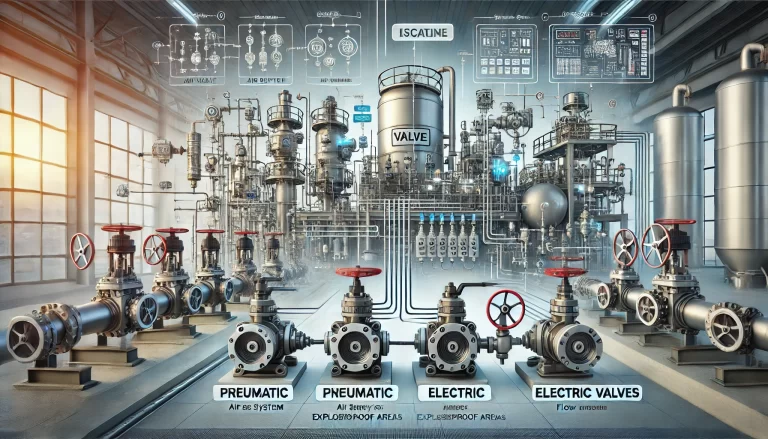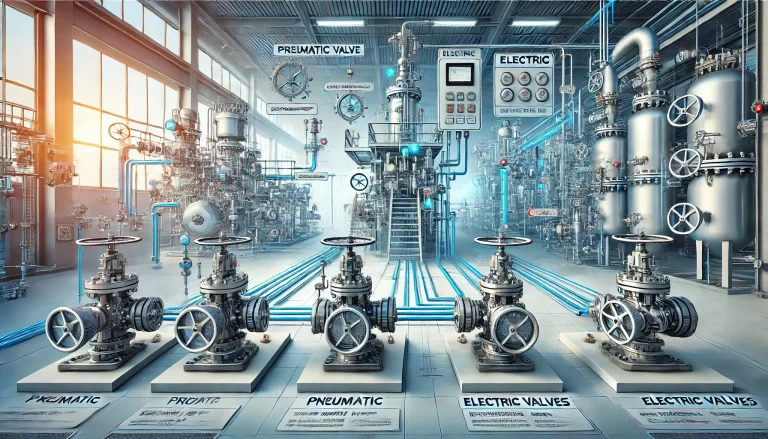In chemical plants, choosing between pneumatic and electric valves depends greatly on specific operational requirements and conditions. Each valve type offers distinct advantages suited to various industrial scenarios. This article explores why chemical plants utilize both pneumatic and electric valves rather than relying solely on pneumatic valves.

1. Safety and Explosion-proof Requirements
Pneumatic Valves: Pneumatic valves use compressed air, eliminating electrical sparks, and thus provide superior explosion-proof safety. They are especially suited for hazardous environments like petrochemical and chemical processing facilities. Pneumatic valves respond rapidly (typically within one second), making them ideal for emergency shut-offs or scenarios requiring frequent and reliable operations.
Electric Valves: Explosion-proof electric valves exist, but due to their motors and electrical circuits, they inherently pose a greater risk of sparking or electrical faults. As a result, their maintenance cost is typically higher. Pneumatic valves remain the preferred choice in highly explosive atmospheres.

2. Precision Control and Adjustment Requirements
Electric Valves: With advanced actuators and digital controls, electric valves achieve precise adjustments (accuracy ±0.1%). They are optimal for scenarios demanding accurate flow or pressure control, such as laboratories, precision reactors, and sophisticated chemical processes. Additionally, electric valves easily integrate with programmable logic controllers (PLCs) and distributed control systems (DCS), allowing complex control logic and remote monitoring capabilities.
Pneumatic Valves: While pneumatic valves typically offer lower precision (±0.5% to 1%), they can meet regular control needs effectively when combined with positioners. They are suitable for applications that do not require extreme precision but do need rapid response, such as large-scale pipeline flow control.
3. Installation Complexity and Dependence on Air Supply
Pneumatic Valves: These valves require a stable air supply, necessitating equipment like air compressors and filtration systems. The initial installation involves considerable investment and complex piping infrastructure. However, if a facility already possesses an air compression system, pneumatic valves offer lower operational costs in the long term.
Electric Valves: Electric valves require only an electrical power source, simplifying installation significantly, particularly beneficial in remote areas or temporary projects without existing air infrastructure. They provide greater convenience and flexibility for small-scale installations or retrofitting existing facilities.
4. Costs and Maintenance Considerations
Pneumatic Valves: Due to their simple mechanical structures, pneumatic valves exhibit lower failure rates and lower maintenance costs, typically involving straightforward replacements of seals or diaphragms. However, they require periodic inspections of air pressure integrity and pipeline seals.
Electric Valves: Electric valves have complex internal components, including motors, gearboxes, and control circuits, which demand specialized technical expertise for repairs and maintenance. Initial investments can be higher; yet, in facilities without air supply maintenance, electric valves can be cost-effective over time.

5. Specialized Industrial Applications
High-Pressure and Large-Diameter Systems: Pneumatic valves provide higher torque, making them preferable for controlling high-pressure and large-diameter piping systems, such as steam management in power plants.
Resistance to Electromagnetic Interference (EMI): In environments with strong electromagnetic interference, pneumatic valves remain unaffected, while electric valves might encounter control malfunctions due to electronic circuit sensitivity.
Case Examples
For instance, petrochemical plants that handle highly flammable gases predominantly use pneumatic valves to minimize explosion risks. Conversely, pharmaceutical companies or precision chemical synthesis labs opt for electric valves, leveraging their precise flow control and automation integration capabilities.

Conclusion and Selection Guidelines
Chemical plants strategically deploy both valve types according to specific operational scenarios:
Pneumatic valves are ideal for explosive environments, rapid-response requirements, high-pressure scenarios, and fail-safe operations.
Electric valves excel in situations needing precise control, flexible installation without air infrastructure, and sophisticated integration with automation systems.
In practice, combining pneumatic and electric valves ensures chemical plants achieve optimal efficiency, safety, and operational reliability tailored to diverse and complex industrial requirements.
